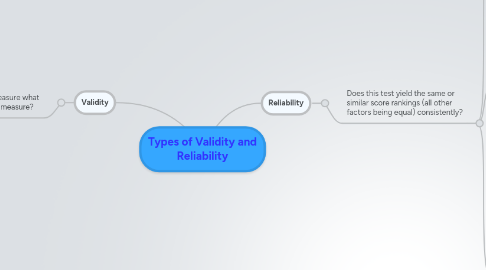
1. Reliability
1.1. Does this test yield the same or similar score rankings (all other factors being equal) consistently?
1.1.1. Test-Retest or Stability
1.1.1.1. A test is given twice and scores are compared
1.1.1.2. To stop students from simply memorizing test questions and answers, use a longer time period between test and retest
1.1.2. Alternate Forms of Equivalance
1.1.2.1. Two forms of the same test are administered to the same students at different times and the scores are compared
1.1.2.2. This methods work best if time between tests is minimal
1.1.2.3. A disadvantage to this method is that it is hard to create two "good" tests
1.1.2.4. Mostly used by test publishers when test security is an issue
1.1.3. Internal Consistency
1.1.3.1. Can be used if the test in question is designed to measure a single concept
1.1.3.1.1. Split-Halves Method
1.1.3.1.2. Kuder-Richardson Methods
2. Validity
2.1. Does this test measure what it is supposed to measure?
2.1.1. Content Validity Evidence
2.1.1.1. Determined by inspecting test questions to see if they coincide with standards that were to be taught
2.1.1.2. Ensures that what is tested is what was taught
2.1.1.3. Does not yield a numerical value
2.1.2. Criterion-Related Validity Evidence
2.1.2.1. Concurrent
2.1.2.1.1. Determined by administering a new test and an established test, to which the new test is to be compared, at the same time and finding the correlation between the two scores
2.1.2.1.2. Creating a new test that proves to be as valid as an older test can be less expensive and take less time to administer
2.1.2.1.3. Yields a numerical value
2.1.2.2. Predictive
2.1.2.2.1. Determined by administering the test to a group and then measuring the same subjects again on the topic that was to be predicted after a period of time has elapsed
2.1.2.2.2. Tells how well a test predicts future behavior
2.1.2.2.3. Example: SAT- predicts how well students will do in college
2.1.2.2.4. Yields a numerical value
2.1.3. Construct Validity Evidence
2.1.3.1. Determined by finding whether test scores correspond with scores on other variables as predicted by a theory
2.1.3.2. There is no second measure to compare nor does this evidence predict future behavior
2.1.3.3. Do these results make sense? (Example: Accountants should do better on a math test than writers)
2.1.3.4. Can yield many numerical values
